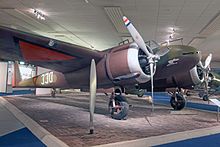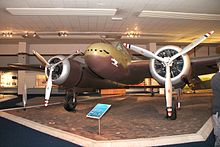Fokker GI
| Fokker GI | |
|---|---|

|
|
| Type: | Fighter plane |
| Design country: | |
| Manufacturer: | |
| First flight: |
March 16, 1937 |
| Commissioning: |
1939 |
| Production time: |
1939-1940 |
| Number of pieces: |
between 62 and 75 |
The Dutch Fokker GI was a twin-engine fighter aircraft of the Second World War . Its unconventional design with double vertical stabilizers on two stabilizer beams and a central fuselage nacelle was unusual.
history
The GI was constructed as a cantilevered middle decker in a wood / metal composite construction. The main wheels drove into the motor gondolas. The two vertical stabilizers were connected to one another by the horizontal stabilizer. The generously glazed crew gondola enabled a good all-round view.
In 1936 the prototype was presented to the public at the Paris Aérosalon . The flight tests began with the first flight on March 16, 1937. Two radial engines Hispano-Suiza 80-02 served as propulsion . The flight performance was good, but the engines were very prone to failure, so they were replaced by two Pratt & Whitney SB-4G . After a show at the end of the year, the Dutch Air Force placed a series order for 36 G.IAs with Bristol-Mercury-VIII drives. Originally, the GI was to be armed with two automatic cannons, two 7.9 mm machine guns and a movable machine gun that fired backwards. The series machines then received eight rigid and one movable machine gun 7.9 mm.
Due to supply bottlenecks for the engines, the first machine was not delivered to the army until July 10, 1939 . When the war began on May 10, 1940, only 23 G.IAs were in service. They were able to record some successes against the German Air Force , especially against Ju 52 . However, almost all of them were destroyed in the fighting in the air or on the ground.
The presentation in Paris in 1936 resulted in a number of export orders. Finland ordered 26, Sweden 18, Republican Spain and Estonia twelve nine of the export version G.IB . Hungary and Denmark negotiated a license production. The delivery to Spain did not take place because of the arms embargo. Of the aircraft destined for Finland, twelve could be completed by the German attack, but they were not armed because the USA had refused to deliver the MGs due to the arms embargo. Together with the machines produced for Denmark, they were taken over by the Air Force, test flown and used as a fighter trainer. The Dutch crew of a G.IB managed to escape to Great Britain during a demonstration flight on May 5, 1941, where their aircraft was also subjected to tests in Farnborough .
The exact number of all GI built is not known, it is likely to be between 62 and 75. A faithful replica of a G.IA can be seen in the Militaire Luchtvaart Museum in Soesterberg (see photos).
Technical specifications
| Fokker G.IA | |
| Parameter | Data |
|---|---|
| Manufacturer | Fokker |
| Year of construction (s) | 1939-1940 |
| length | 11.50 m |
| Wingspan | 17.14 m |
| height | 3.40 m |
| Wing area | 38.30 m² |
| drive | two air-cooled nine-cylinder radial engines Bristol Mercury VIII |
| power | 618 kW (840 PS) each |
| Top speed | 475 km / h at an altitude of 2750 m |
| Marching speed | 355 km / h at an altitude of 2750 m |
| Rise time | 8 min at 5000 m 8.9 min at 7000 m |
| Service ceiling | 9300 m |
| Range | 1400 km |
| Empty mass | 3323 kg |
| Takeoff mass | maximum 4790 kg |
| crew | 2-3 |
| Armament | eight rigid 7.9 mm MG in the bow of the fuselage and a movable 7.9 mm MG in the rear of the fuselage |
Countries of operation
-
 Netherlands
Netherlands
-
 German Empire
German Empire
-
 United Kingdom (tests only)
United Kingdom (tests only)
Unrealized production orders:
-
 Denmark (production license)
Denmark (production license) -
 Estonia (9 machines)
Estonia (9 machines) -
 Finland (26 machines)
Finland (26 machines) -
 Sweden (18 machines)
Sweden (18 machines) -
 Spain (12 machines)
Spain (12 machines) -
 Hungary (production license)
Hungary (production license)




